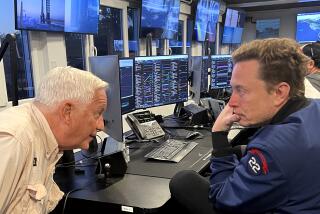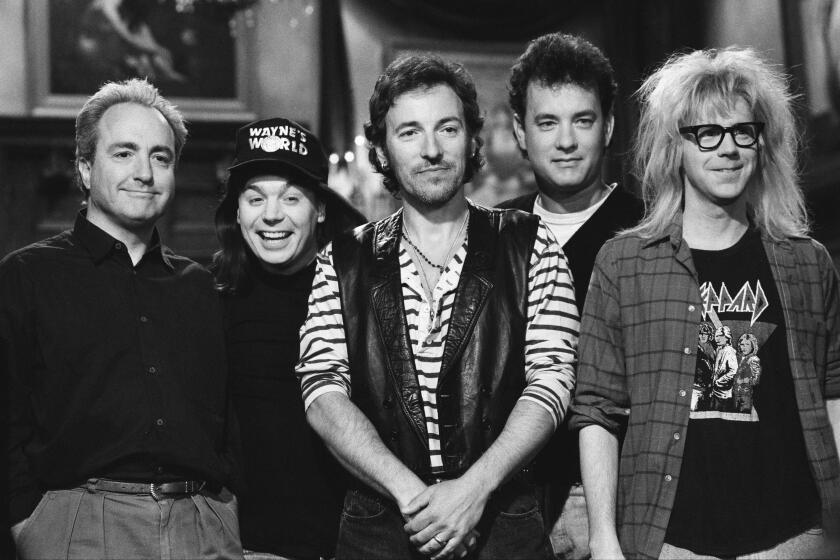BOOK REVIEW / SCIENCE : Shining a Light on Edison’s Private Life : EDISON: Inventing the Century; <i> Neil Baldwin</i> ; Hyperion; $27.95, 518 pages
- Share via
Some people’s lives so represent their times that had they not lived, it would have been necessary to invent them. Thomas Edison saved us the trouble by not only inventing so many of the machines that created our world, but by inventing the myth that explains his role in their creation.
Edison, of course, turned Americans on to electricity and, through no intention on his part, turned us into consumers of packaged entertainment.
Neil Baldwin’s highly readable biography does not tear down the familiar myth so much as fill it out. While not dulling our schoolbook images of Edison-as-genius, Baldwin portrays the warts we expect to find on yesterday’s heroes.
This is not the first Edison biography. Earlier authors have focused on Edison’s polished reminiscences of his Horatio Alger-like rise from the poor, unschooled but honest lad who, at 14, went to work for the telegraph company and soon became a millionaire. Others have written about the 1000-plus inventions he patented--including the incandescent light bulb, the phonograph, the kinescope--or the prototypal research and development laboratory he established in Menlo Park, N.J.
Baldwin acknowledges these accounts but focuses instead on the underreported aspect of Edison’s life that he suspects will interest readers in 1995: the private Edison--by today’s ethos a lousy husband and father--whose dereliction of patriarchal duties Baldwin attributes to extraordinary ambition, energy and, above all, a genius for invention.
To make his case, Baldwin braved the enormous and barely catalogued archives at the Edison Library in West Orange, N.J., and met and interviewed surviving family members. Leaving no stones unturned, Baldwin read the books available to Edison in Edison’s hometown library.
He also met urban archeologists at the site of the original Edison homestead in Port Huron, Mich. (where he saw copies of an early newspaper printed by the young inventor). From the smell and feel of these artifacts as well as from written records, Baldwin reconstructs the tone and texture of Edison’s world.
The Old Man (as he was already called when he was under 40) could have passed today’s rigorous presidential screening. He was neither womanizer nor partaker of addictive substances. His obsession was work, fed by an imperial sense of its worth. He did, after all, invent remarkable things during the 18-hour days that filled most of his 70 working years.
Baldwin’s Edison knew and mixed with some of the most remarkable people of his time. Through one daughter he met the American philosopher and psychology pioneer William James. Through the other he met the artists who had just moved into and transformed turn-of-the-century Greenwich Village into a center for American’s nascent avant-garde. Through his corporate connections he befriended Henry Ford, with whom he shared camping trips, dreams and prejudices.
Edison made the most of the hand dealt him. Acutely hearing-impaired, he claimed this as an asset that insulated him from the “nerve strain” of modern life, allowing him to concentrate. The visiting Italian pedagogue Maria Montessori did not see it that way. She wept when she saw him bite into the side of a grand piano in order to feel the vibrations when someone played.
Edison’s inventive genius was not always business genius. While he did “think globally” about electric grids for whole cities, he misguidedly preferred direct current (DC) over today’s standard, alternating current (AC). He was also wrong about the potential of an entertainment market--maybe because he had no time for leisure.
Whatever the reason, he struck out three times: on phonograph records as entertainment; on moving pictures--which Edison saw only as an educational device, and at the end of his life on radio--which he described as a fad.
While Baldwin delineates Edison’s character strengths and blind spots, he neglects the Edison who is inevitably present in biographies of contemporary inventors. This monster Edison--the ruthless, unscrupulous businessman whose cadre of lawyers preempted or undercut the inventions of other men--is not addressed.
Also absent is the boss who punched the time clock with his employees, demanded loyalty and hard work, but responded in kind (e.g. by caring for the widow and children of his protege Clarence Dally, who died from radiation exposure after experimenting with Edison’s early X-ray machines).
Baldwin’s last biography was about Man Ray, another self-made American original who inventd a new kind of photography as an art form in the years before World War II. “Edison” is its companion piece, an argument for classifying the inventor-businessman as a creative genius.
In our own end-of-century infatuation with private enterprise, Edison is again a model for aspiring capitalists. They should note that he worked hard, investing perspiration in his inspirations, kept the long-term in view by supporting research and development, paid his employees well and always remained loyal to them. “Downsizing” was never part of the Edison corporate vision.
More to Read
Sign up for our Book Club newsletter
Get the latest news, events and more from the Los Angeles Times Book Club, and help us get L.A. reading and talking.
You may occasionally receive promotional content from the Los Angeles Times.










